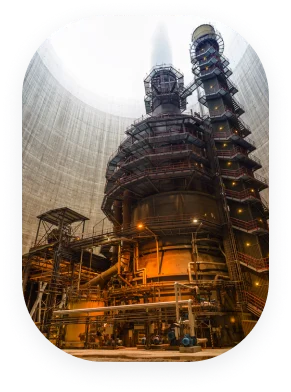
Lighthouse ERP
Thermal Power Plant
Simple to Use
Easy to Implement
Flexible to Customized Solution

The power sector in India presents a unique set of challenges, marked by its scale, regulatory complexity, and the need for precise coordination across departments and project sites. Managing fixed assets, plant maintenance, work orders, critical inventory, location-wise inventory carrying costs, and field service operations demands a purpose-built, industry-focused ERP solution.
Lighthouse ERP for Engineering & Project Management is a robust, Oracle-based ERP software tailored specifically for power generation, utility, and infrastructure companies. It incorporates industry-specific modules such as plant maintenance, fixed asset management, inventory control, finance, procurement, and field service management, ensuring that all critical aspects of power project execution are managed effectively under a unified system.
By automating core processes and providing real-time visibility into operations, Lighthouse ERP empowers businesses with greater control over budgeting, scheduling, supply chain coordination, and material resource planning. The system supports strategic decision-making, enhances vendor and contractor collaboration, improves risk management, and significantly reduces delays and operational costs delivering higher efficiency and project transparency across the board.


Manual handling of tenders and subcontractor tracking leads to selection delays and poor accountability.

Lack of clear project hierarchy and poor communication across sites cause overlaps and execution delays, which arises the need of task management module.

Inaccurate forecasting and absence of automated tracking systems result in budget escalations and slippages.

Unavailability of real-time data leads to resource underutilization and disrupted site cash flow which could be solved with erp modules.

Missing risk registers and undocumented site events expose projects to operational and legal risks.

Paper-based billing and poor insurance monitoring lead to invoicing errors, disputes, and missed renewals.

Project documents, updates, and approvals remain siloed across teams, affecting visibility and control.

ERP for power plants enables seamless tender evaluation, bid submissions, and subcontractor work allocation all tracked on a unified platform for better control and timely execution.
With project management module in ERP work Breakdown Structure (WBS) supports hierarchical project segmentation, material/service mapping, and WBS-level risk tagging with regular reviews to prevent disruptions.
Power generation ERP solutions streamline budgeting, timeline forecasting, and real-time tracking of manpower, machinery, and materials across stages for enhanced planning and efficiency.
With thermal power ERP software, tasks can be broken down by camp or section while enabling smooth fund requisition, approval, and tracking from site to head office.
ERP systems for the power sector support preparation of running bills and measurement books, linked with the sales and distribution module and finance modules to ensure accurate client invoicing and payment cycles.
From weighbridge monitoring to on-site incident logging, ERP-based powerplant software enables secure, auditable records to ensure transparency and compliance across all units.
Power ERP provides centralized control over project documents, tasks, and insurance records, with integrated finance module support for managing claims and policy renewals.
Enables grade-wise tracking and management of coal and other fuels across multiple locations, ensuring efficient movement and availability of raw materials and consumables.
Generates cost center-specific reports to monitor and control project-related expenses, helping prevent budget overruns at every stage of execution.
Provides detailed MIS dashboards comparing daily raw material consumption and electricity generation against budgeted values, enabling better decision-making.
Offers end-to-end MIS reporting for auxiliary, imported, exported, and self-use power, ensuring clear visibility into billing and usage across all streams.
Captures and monitors Distributed Control System (DCS) data from various generating stations, offering insights into real-time plant parameters and performance.
Supports preventive, predictive, and breakdown maintenance with automated notifications. Tracks plant machinery health to reduce downtime and improve asset utilization.
Maintains comprehensive equipment logs, including tool and consumable usage, fuel and lubricant consumption, spare part costing, production losses, and detailed breakdown analysis.